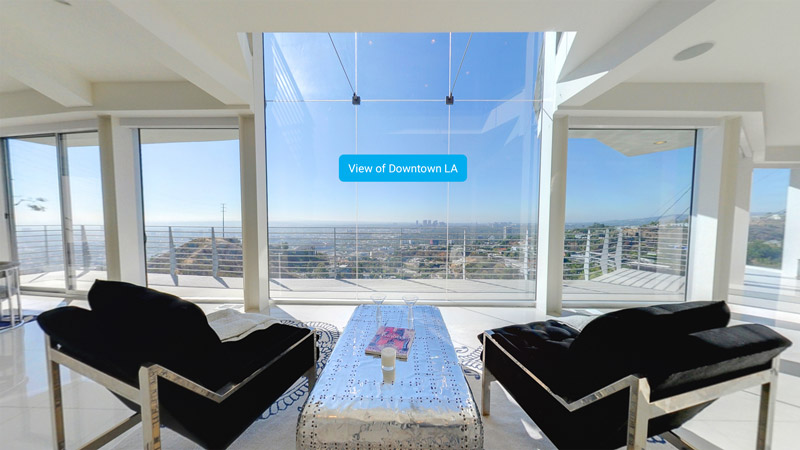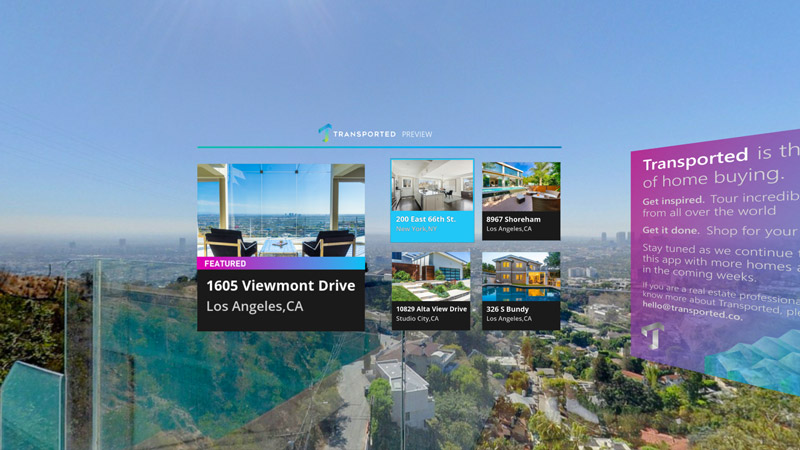Lessons from bringing VR storytelling to real estate
One of the exciting areas of potential within virtual reality applications is the potential for storytelling. Transported is a platform for real estate agents which brings storytelling into the fold in a really fascinating way. David Green, CTO of Transported, spoke at VR/AR With The Best and shared a few moments of his time to talk about their approach to VR.

A few screens from the Transported app
David explains the idea behind Transported like so,
“Transported is a platform for real estate agents to create compelling VR walkthroughs and a marketplace for buyers to view them all in one place with a consistent easy user interface. VR now allows buyers to view many homes in under an hour and then drive to only the few they actually want to visit.”
Finding the potential in a VR app idea
David was previously a CTO working to make real-time social displays for events like the Superbowl and Lollapalooza (that’s pretty huge!). The CEO of Transported approached him with the idea and David saw the potential straight away, he was a recent home buyer himself —
“The CEO sold me on the fact that Real Estate could be the killer app for VR (outside of the obvious gaming benefits). Simply doing the math on how it would benefit buyers and sellers finding homes, especially combined with the fact I had literally just gone through buying my latest home myself.”
When looking for a potential audience for your next VR app, David’s story provides some good insight. The Transported team didn’t just look at the math involved, they saw an existing, incredibly passionate community existed around home buying. David recognised “the obsession people have with channels like HGTV“ and noticed that there are people out there who “love visiting open homes”. So the app had a potential audience even outside of the home buying process. All good signs.
Overcome resistance by explaining and showing real benefits
How do you entice people to value a new platform built for emerging tech like virtual reality? David said there was a level of resistence they came up against, but they focused on the real value they could bring, rather than the tech itself.
Their platform “can cut the number of homes you visit in real life down by a huge percentage by letting the buyer cross that threshold without making the trip”. Showing people that the app can save them time has helped overcome their initial resistance — “If I can take twenty homes and cut the number you visit down to two then I have saved you and the agent valuable time. Once explained in this context, resistance fades away.” Time is definitely one of people’s most precious assets!

A wonderful view of downtown LA!
To sell people VR, show people VR
Another way to overcome resistence to the idea of VR, in particular, is to show people VR for them to truly understand the concept. As David recounts, “We recently visited the California Association of Realtors conference in LA and gave agents a preview of the Transported platform, no one left disappointed. Without experiencing VR first hand it can be easy for people to dismiss it”.
“if you want to sell someone on your concept for a VR app, put them in your VR app” — David Green
Bringing in storytelling
I’ve noticed real estate and VR have been drawn to each other quite a lot in this reemergence of virtual reality as a medium. Doing a 360 of different rooms in a home for real estate was an easy enough use case for many VR agencies to find. What I love about the idea behind Transported is that they also provide a way for real estate agents to narrate a walk through, putting a story to it and making it genuinely like a pre-recorded, immersive open house. Virtual reality can be quite strong as a storytelling medium, so this approach really might take it to new heights. When I mentioned this, David pointed out that “it is the core concept of Transported, the walkthrough gives an acute sense of a home’s makeup, how rooms connect and what those rooms entail.”
Test your VR apps and check your design decisions
When I asked about mistakes their team made that other developers could learn from, David mentioned three areas people should keep in mind — “menu placement, immersion and comfort”. All three can be linked quite strongly. David explained with an example, “having menus on the floor causes discomfort to the user having to look down a lot as they progress through the walkthrough”. It can even be more than just placement and strain from looking down — “even small flashing menus can have a distracting effect ruining immersion”.

An example of the menus in Transported
Finding content
Every platform like this requires content. Transported in particular relies on real estate agents taking 360 captures and recording narration. Luckily for the Transported team, real estate agents are quite good at doing the narration for the experience. David pointed out that “estate agents are very good at placing the buyer in the home and narrating the VR walkthrough comes as second nature to them.” He has also found that the 360 images have been slightly easier for some agents than still photos!
Thank you to David for sharing some of Transported VR‘s experience! You can keep up with the latest Transported news on their Twitter at @transportedvr.
Know other emerging tech enthusiasts who might want to read this too? Please like and share this post with them!
Contact Dev Diner to request official republication of this article.
Want more?


